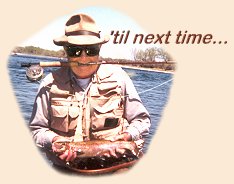
| ||
|
December 22nd, 2003
|
|
Q. From PulauPDSS: I have an entomology/environmental question for you that has been bugging ("ha ha") me for a long time. Are trout and mayfly environmental requirements largely the same, or do they differ? If they differ, how much? The reason I ask is that I live close to the Missouri river in the midwest, and there are heavy mayfly hatches; however, I believe the water locally is too turbid and warm for trout - at least I think so. Also, a related question, does the presence of any certain "bug" indicate the likely presence of trout? Thanks in advance.
A.
The answer to your dilemma is that "mayfly" as you
are using it really covers a very large number of
species (one authority lists over 500 species in
No. America), and the environmental requirements
for them range from still to flowing water, warm
to cold water, and with varying food requirements.
Mayflies, in general, are usually found in cold,
well-oxygenated, unpolluted waters so that they do
have a history of being associated with trout
populations. The mayflies that I suspect you are
seeing hatching from the Missouri are members of
the family Ephemeridae. These are large, burrowing
mayflies which construct tubes in the mud bottom and
use their gills to create a water current through the
tubes to bring in microscopic food particles. These
are much different from the smaller, cold-water forms
which are active foragers on and between the stones
in mountain trout streams. So, the answer to your
question is "yes" and "no" - it depends on what
mayflies you are talking about in terms of their
environmental requirements being similar to trout.
I know of no certain "bug" that indicates the
presence of trout. Water quality biologists have
come up with a series of rankings that they have
assigned to various aquatic insects that indicate
their tolerance to pollution. They calculate
indices by combining the numbers of different bugs,
multiplying by their tolerance index, summing these
and dividing by the number of bugs. This gives a
"biotic index" which can roughly give an indication
of water quality, which in turn, can give you an idea
of whether or not you might find trout there.
~ C. E. (Bert) Cushing, aka Streamdoctor 105 W. Cherokee Dr. Estes Park, CO 80517 Phone: 970-577-1584 Email: streamdoctor@aol.com
|
| If you would like to comment on this or any other article please feel free to post your views on the FAOL Bulletin Board! |
 The 'Stream Doctor' is a retired professional stream ecologist and
author, now living in the West and spending way too much time
fly-fishing. You are invited to submit questions relating to
anything stream related directly to him for use in this Q & A Feature
at
The 'Stream Doctor' is a retired professional stream ecologist and
author, now living in the West and spending way too much time
fly-fishing. You are invited to submit questions relating to
anything stream related directly to him for use in this Q & A Feature
at